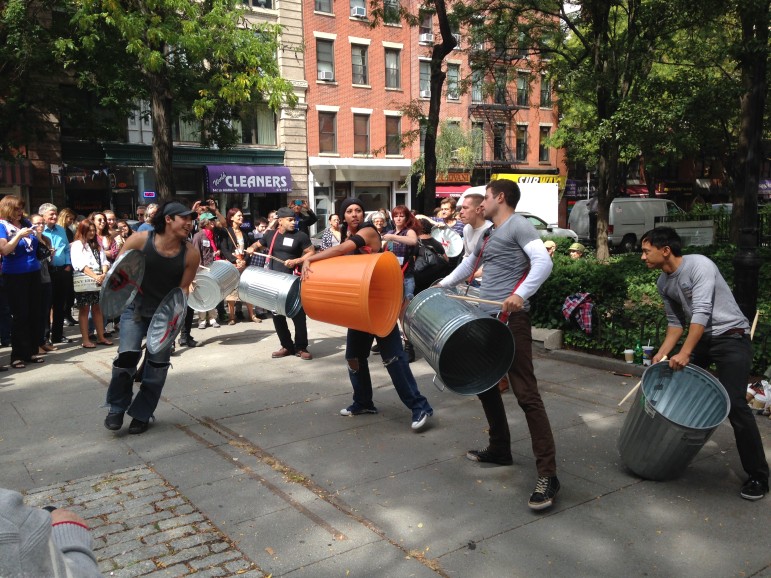
Sylvia Morse
A September 2014 rally in support of a lawsuit by local organizations to stop the NYU plan.
Despite strong local opposition, New York University won approval last month to dramatically expand its core campus in Greenwich Village. The plan was subject to extensive planning and public review, but was ultimately green-lit by the State Court of Appeals. Why was this neighborhood planning issue, like so many others, resolved in the courts?
New York City communities—from East New York to the South Bronx—invest time and effort in planning their neighborhoods. Yet, as Greenwich Village residents found, the city’s land use planning and environmental review processes offer little opportunity for meaningful public involvement.
The plan
Over the next two decades, NYU will build up to two million square feet of faculty housing, classrooms, and offices on several blocks in Greenwich Village. At the center of the “NYU 2031” development plan are two “superblocks” between Houston and West Third Streets and LaGuardia Place and Mercer Streets. Currently, they contain two NYU-owned residential developments, an NYU gym, one-story shops, and City-owned green spaces including a playground, dog run, and community garden. The gym and open spaces would be built over, and the density of the “towers-in-the-park” style superblocks increased.
The plan required special permission from the City, including zoning changes to allow larger, taller buildings and actions to permit development on public land. These actions are subject to the City’s Uniform Land Use Review Procedure (ULURP) and environmental review, which require public noticing and hearings. ULURP includes a rigid clock for advisory review by the local Community Board and Borough President, and approval by the City Planning Commission and, in many cases, City Council.
The ULURP process began in 2011, but NYU 2031 planning began much earlier. Based on lessons from past development battles, NYU held dozens of meetings with the public before submitting a proposal to the City. Then-Manhattan Borough President Scott Stringer also facilitated a Community Task Force. Participants were frustrated because NYU repeatedly presented plans rather than soliciting ideas, and the task force report ignored community consultation. When the final 2011 plan did not reflect community priorities, residents set out to press their concerns through the city planning process.
Local opposition and the city planning process
Residents, NYU faculty and students, and neighborhood organizations raised numerous concerns about the expansion plan, including:
- Displacement of community-built playgrounds, gardens, and other parks in a neighborhood starved for open space;
- Environmental, social, and economic impacts of added density and twenty years of construction;
- Effects of NYU’s growing footprint and privatization of public land on neighborhood character; and
- NYU’s faithlessness to previous community agreements (NYU 2031 violated past development deals).
Greenwich Village advocates maximized opportunities to address these concerns through ULURP.
Unlike many less-privileged neighborhoods, this now-wealthy, historically activist community was well-positioned to mobilize neighbors, sophisticated advocacy groups, celebrity support, and private funds. Hundreds attended public hearings and protests and commented on the environmental review. Planning and preservation experts and seasoned local advocates analyzed the project’s potential impacts proposed alternatives. The Community Board conducted an exhaustive planning and environmental analysis that informed its unanimous vote against the plan.
Residents notified public officials of their findings but had little impact on their approvals. After one of its longest hearings on record, the City Planning Commission approved the plan with some modifications, including modest building height reductions (negotiated by the Borough President). The one dissenting Commissioner cited NYU’s “haphazard and insensitive” growth to date. City Council members—siding with the local representative, as is common practice—approved the plan with just one dissent. (Some opponents speculated that their councilmember ignored constituent pressure because an upcoming redistricting would remove Greenwich Village from her district.)
The myth of participation in public review
The public has a limited role in city planning decisions. New York City and State land use and environmental review requirements, which are rooted in the “sunshine” reforms of the 1970s, require that government reviews and discloses potential impacts of certain decisions. The City must consider public comment and alternatives, but is not required to incorporate these into their plans. As a result, residents’ painstaking research and organizing often amounts to performance. The City does have instruments for community planning, but these are non-binding.
The NYU 2031 public review met all public outreach requirements. But residents wanted more than to speak on record. They believed that “being a New Yorker means playing an active role in shaping your local communities,” as the City attests on its community affairs website. By that measure, the ULURP process failed Greenwich Village.
That a mostly wealthy, white, politically connected community could not influence the process suggests the even greater hurdles faced by low-income communities of color.
Courts as the planning entity of last resort
Ignored in the public planning process, NYU 2031 opponents (like activists in Harlem, Brooklyn Heights, and Willets Point) turned to the courts. Legal challenges, unlike planning policy decisions, are typically narrow: Did the City neglect environmental review requirements? Does a proposal comply with civil rights law? In this case, does a development violate land use law?
The courts evaluated whether the superblocks’ open spaces were parks, which cannot be ‘alienated’ (used for non-parks purposes) without special State legislation. The green spaces belong to the Department of Transportation (a quirk of the community’s defeat of Robert Moses’ plan for a Lower Manhattan highway) and not mapped as parkland. Without official designation as parks, the courts had to decide whether these spaces were parkland by implication.
The lawsuit could not address most community planning concerns. That residents helped plan, build, and care for the green spaces increased their community value, but did not legally make them parks. The area’s already minimal open space access was irrelevant. Whether a private university should expand beyond existing zoning and on public land had no bearing either. Such questions of how to best use neighborhood space have more than one answer and are seldom defined in our laws for precisely that reason.
Re-thinking ULURP
New Yorkers want to make decisions that shape their neighborhoods. Right now, residents are organizing around major developments in Chinatown and City rezonings in East New York. The city planning process guarantees that they may speak, but not that they will be heard.
Echoing the recommendations of many planning experts and neighborhood activists, several reforms would increase community participation in land use review:
- Develop binding community-based neighborhood plans that guide all planning decisions. ULURP is designed to review complete proposals, not envision a range of possibilities for neighborhood space.
- Strengthen community boards. Though established in response to the negative impacts of top-down, comprehensive planning, board recommendations are non-binding. They should be substantively incorporated into City Planning and Council review. A proposal to require funding for planners at every board would give boards the capacity to develop sound analyses of plans and alternatives. (It must be noted that resident voices are not all represented by community boards, and community planning and engagement extends beyond these entities.)
- The City Planning Commission and City Council must vote on plans as they were presented to the public. Now, unofficial negotiations modify plans after community board review, which undermines public involvement while giving the illusion of compromise. Any plan alterations during the ULURP process should be the result of a publicly documented and participatory review by all reviewing bodies.
- End the City Council’s de facto policy of voting with the local elected official. Every land use action has citywide implications. With planners at the community boards and City Council, councilmembers have the resources to make informed decisions about neighborhoods, even if they do not represent them.
New Yorkers know their neighborhoods and want to plan for their futures. The City must invest in community-based planning and give greater decision-making power to residents.


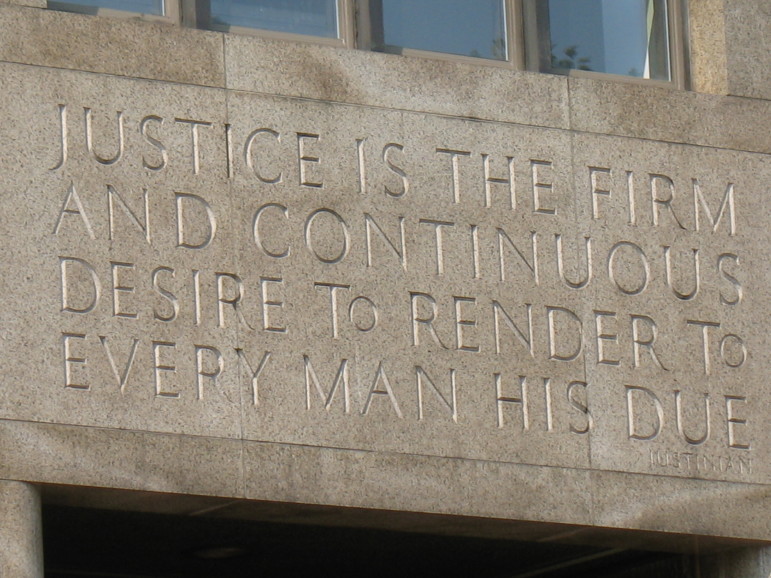

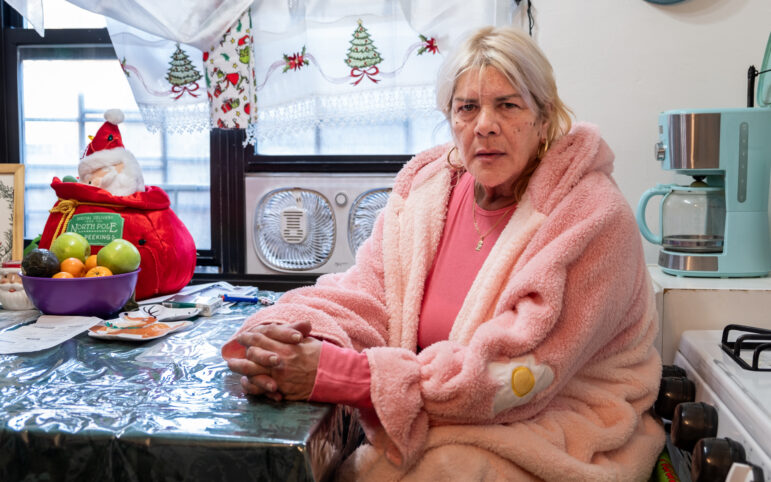
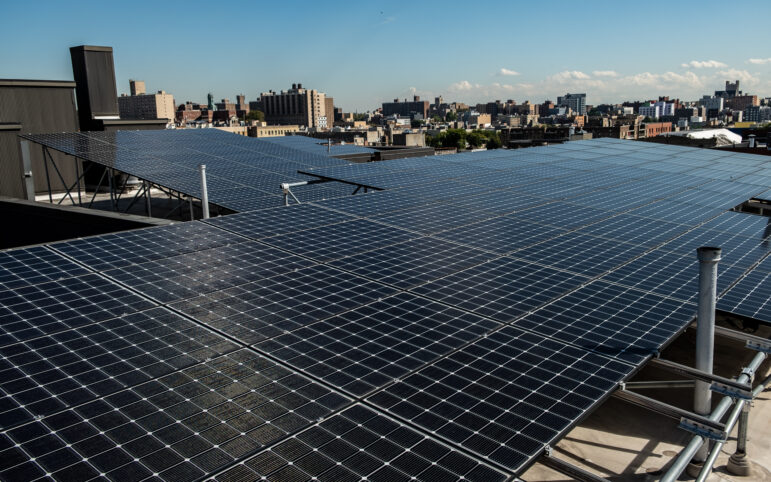
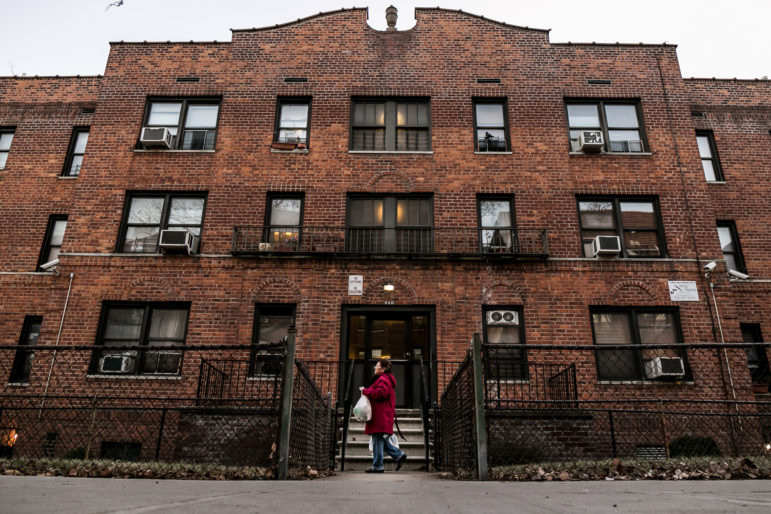


11 thoughts on “Op-ed: NYU Controversy Shows it’s Time to Rethink City Planning Process”
This corroborates (in great detail) what many New Yorkers feel: the planning process is symbolic placation, decisions are still made behind closed doors. Margaret Chin should be ashamed!
Thank God that their are sensible decision makers with a wide sense of social responsibility, that can hide behind closed doors from the likes of you and your garbage can beating mob. I’m quite sure that several of the mob members have trust funds, else how could they all afford to be in the Village beating their cans and not be productively employed.
It does not follow because Village residents did not get the outcome they sought; “no material development on the land”, that the process is defective. After all they also had “their day in court” and lost there too.
In the big picture NYU is a very important employer providing 40,000+ NYC jobs, and thus also a substantial source of NYC income tax payments by NYU’s employees. NYU is also an important world class educational institution. Education is the KEY to the our cities’ progress, Americas’ progress and civilizations’ progress. NYU has a small endowment for a school of its size and importance. NYU does need to grow in order to fulfill its goals of expanding educational opportunities. They are located in one of the worlds most expensive real estate markets. So if NYU lost they would need to cut back on the basic mission of education, or raise tuition. The winner of this struggle if NYU loses, would be the very rich privileged people who live in Greenwich Village. Who’s interest do you prefer; educational opportunities and social progress, or the privileged lives of Village residents who want nothing (including any social responsibility to improve educational opportunities beyond annual alumni contributions to their Ivy League alma maters) to impinge their quite enjoyment of their rich privilege lives?
The point is to show that even a rich, organized constituency such as Greenwich Village was unable to affect the planning process at all or get any concessions from NYU in exchange for a public giveaway of land. If the wealthy, organized Greenwich residents couldn’t manage to change anything, do low-income communities stand any chance at all? It’s a commentary on the process as much as a commentary on the outcome.
Yes, NYU is a big employer. But that doesn’t mean they own the public space or the people that they share the neighborhood with. If NYC doesn’t give them everything they want for free, do you really think they’re going to close their doors? Seems like the same old story of a big corporation crying wolf in order to extort tax breaks and free land out of a municipality. Further, NYU is hardly ‘expanding educational opportunities’ with their absurd tuition. Their expansion isn’t about increasing educational access, it’s about owning more land and generating more money.
The point is not Greenwich Village rich or poor; the outcome is good evidence that the process was just, being that the process was reviewed in both the political process, and in the courts. Low income communities stand every chance of derailing a faulty taking of land, if their claim has validity. You need to admit that as possible, or this discussion makes no sense other then you’re right in whatever you claim. In short why should the Village be able to shake down NYU for automatic concessions on its reasonable project, that is in the interests of the larger society?
The point about NYU as a big employer is to remind you that NYU makes important contributions to our NYC government economy, as well as our culture and society.
Your point about this binary choice is absurd; “doesn’t give them everything they want for free, do you really think they’re going to close their doors?” of course not. But that is hardly ever the choice; these kinds of choices happen on the MARGIN; their will be fewer classrooms, fewer departments, fewer students and ultimately less education and finally less progress. It’s not about NYU crying wolf, this story is about rich selfish privileged people not feeling any social responsibility to the society and civilization they live in; a culture of Greenwich Village narcissism; “me, mine and my – my dog used to crap there”.
NYU is expanding educational access by creating more physical space for educational opportunity. For without new space, there will be no place for new students to “be” and thus no new educational opportunities for those students. NYU’s tuition is high, but only in the same way as all of higher education in this country has high tuition. Shall they wait for the whole US education system to be reformed before building? I think not. You seem to have missed my most obvious point, so let me make it simple for you; If NYU has to go spend a lot more money to buy more land so you and your selfish friends can keep this small odd piece of green building buffer (Washington Square Park is clearly not enough for you and your selfish neighbors; it would be a blessing from heaven for me) an amenity of small value to reasonable folks, then real educational opportunities are lost to society. Without this small amount of marginal land, NYU will have to spend a lot of money buying land ( you and your selfish neighbors will probably object to that purchase also) that could alternatively go to new class space, new scholarships, new programs and new student housing. In short you want to stifle education for chicken shit, because of selfish narcissistic people who know the value of nothing important.
NYU couldn’t have survived another day or taught another student without this colossal ridiculous land-grab.
NYU survival is NOT the issue; if you want to create your own straw man and knock him over I will not reply again. The ISSUE is GROWING NYU and educational opportunities for the world, and how important that is to NYC, America and the world. The other issue is the trade off between the value of increased education and a small amount of green space around some buildings and the conflict that the loss of that green space brings with a silly small part of a Greenwich Village neighborhood that is full of narcissistic rich privaled people who prize this small green space above the universal value, support and need for education.
NYU should change it’s name to NYUR ” New York University Realtors”.
NYU owns many properties, from public records:
NYU
OWNER
HNUM_LO
STR_NAME
NEW YORK UNIVERSITY
000000000421
1 AVENUE
NEW YORK UNIVERSITY
000000000429
1 AVENUE
NEW YORK UNIVERSITY
000000000433
1 AVENUE
NEW YORK UNIVERSITY
000000000540
1 AVENUE
NEW YORK UNIVERSITY
000000000107
2 AVENUE
NEW YORK UNIVERSITY
000000000031
3 AVENUE
NEW YORK UNIVERSITY
000000000067
3 AVENUE
NEW YORK UNIVERSITY
000000000316
3 AVENUE
NEW YORK UNIVERSITY
000000000316
3 AVENUE
NEW YORK UNIVERSITY
000000000316
3 AVENUE
NEW YORK UNIVERSITY R
00000001 1/2
5 AVENUE
NEW YORK UNIVERSITY
000000000035
5 AVENUE
NEW YORK UNIVERSITY
000000000060
5 AVENUE
NEW YORK UNIVERSITY
000000000970
5 AVENUE
NEW YORK UNIVERSITY
000000000100
BLEECKER STREET
NEW YORK UNIVERSITY
000000000726
BROADWAY
NEW YORK UNIVERSITY
000000000713
BROADWAY
NEW YORK UNIVERSITY
000000000715
BROADWAY
NEW YORK UNIVERSITY
000000000787
BROADWAY
NEW YORK UNIVERSITY S
000000000025
CENTRAL PARK WEST
NEW YORK UNIVERSITY
000000000016
COOPER SQUARE
NEW YORK UNIVERSITY
000000000007
EAST 10 STREET
NEW YORK UNIVERSITY
000000000120
EAST 12 STREET
NEW YORK UNIVERSITY
000000000007
EAST 12 STREET
NEW YORK UNIVERSITY
000000000106
EAST 14 STREET
NEW YORK UNIVERSITY
000000000126
EAST 14 STREET
NEW YORK UNIVERSITY
000000000335
EAST 24 STREET
NEW YORK UNIVERSITY
000000000334
EAST 25 STREET
NEW YORK UNIVERSITY
000000000330
EAST 25 STREET
NEW YORK UNIVERSITY
000000000339
EAST 25 STREET
NEW YORK UNIVERSITY
000000000334
EAST 26 STREET
NEW YORK UNIVERSITY
000000000227
EAST 30 STREET
NEW YORK UNIVERSITY
000000000227
EAST 30 STREET
NEW YORK UNIVERSITY
000000000227
EAST 30 STREET
NEW YORK UNIVERSITY
000000000433
EAST 30 STREET
NEW YORK UNIVERSITY
000000000227
EAST 30 STREET
NEW YORK UNIVERSITY
000000000038
EAST 7 STREET
NEW YORK UNIVERSITY
000000000014
EAST 78 STREET
NEW YORK UNIVERSITY
000000000003
EAST 78 STREET
NEW YORK UNIVERSITY R
000000000006
EAST 8 STREET
NEW YORK UNIVERSITY R
000000000022
EAST 8 STREET
NEW YORK UNIVERSITY R
000000000018
EAST 8 STREET
NEW YORK UNIVERSITY R
000000000016
EAST 8 STREET
NEW YORK UNIVERSITY R
000000000012
EAST 8 STREET
NEW YORK UNIVERSITYRE
000000000036
EAST 8 STREET
NEW YORK UNIVERSITY
000000000227
EAST 9 STREET
NEW YORK UNIVERSITY S
000000000505
GREENWICH STREET
NEW YORK UNIVERSITYSC
000000000534
HUDSON STREET
NEW YORK UNIVERSITY S
000000000099
JANE STREET
NEW YORK UNIVERSITYLA
000000000099
JANE STREET
NEW YORK UNIVERSITY S
000000000099
JANE STREET
NEW YORK UNIVERSITY,A
000000000509
LA GUARDIA PLACE
NEW YORK UNIVERSITY
000000000543
LA GUARDIA PLACE
NEW YORK UNIVERSITY
000000000567
LA GUARDIA PLACE
NEW YORK UNIVERSITY
000000000566
LA GUARDIA PLACE
NEW YORK UNIVERSITY
000000000130
MAC DOUGAL STREET
NEW YORK UNIVERSITY
000000000425
MAIN STREET
NEW YORK UNIVERSITY
000000000425
MAIN STREET
NEW YORK UNIVERSITY
000000000425
MAIN STREET
NEW YORK UNIVERSITY
000000000425
MAIN STREET
NEW YORK UNIVERSITY
000000000425
MAIN STREET
NEW YORK UNIVERSITY
000000000425
MAIN STREET
NEW YORK UNIVERSITY
000000000425
MAIN STREET
NEW YORK UNIVERSITY
000000000425
MAIN STREET
NEW YORK UNIVERSITY
000000000425
MAIN STREET
NEW YORK UNIVERSITY
000000000425
MAIN STREET
NEW YORK UNIVERSITY
000000000425
MAIN STREET
NEW YORK UNIVERSITY
000000000425
MAIN STREET
NEW YORK UNIVERSITY
000000000425
MAIN STREET
NEW YORK UNIVERSITY
000000000425
MAIN STREET
NEW YORK UNIVERSITY
000000000425
MAIN STREET
NEW YORK UNIVERSITY
000000000425
MAIN STREET
NEW YORK UNIVERSITY
000000000425
MAIN STREET
NEW YORK UNIVERSITY
000000000425
MAIN STREET
NEW YORK UNIVERSITY
000000000425
MAIN STREET
NEW YORK UNIVERSITY
000000000425
MAIN STREET
NEW YORK UNIVERSITY
000000000425
MAIN STREET
NEW YORK UNIVERSITY
000000000425
MAIN STREET
NEW YORK UNIVERSITY
000000000425
MAIN STREET
NEW YORK UNIVERSITY
000000000425
MAIN STREET
NEW YORK UNIVERSITY
000000000425
MAIN STREET
NEW YORK UNIVERSITY
000000000425
MAIN STREET
NEW YORK UNIVERSITY
000000000425
MAIN STREET
NEW YORK UNIVERSITY
000000000425
MAIN STREET
NEW YORK UNIVERSITY
000000000425
MAIN STREET
NEW YORK UNIVERSITY
000000000425
MAIN STREET
NEW YORK UNIVERSITY
000000000246
MERCER STREET
NEW YORK UNIVERSITY S
000000000001
MORTON SQUARE
NEW YORK UNIVERSITYSC
RIVER ROAD
NEW YORK UNIVERSITY
000000000034
STUYVESANT STREET
NEW YORK UNIVERSITY
000000000028
STUYVESANT STREET
NEW YORK UNIVERSITY
000000000230
SULLIVAN STREET
NEW YORK UNIVERSITY
000000000249
SULLIVAN STREET
NEW YORK UNIVERSITY
000000000238
THOMPSON STREET
NEW YORK UNIVERSITYRE
000000000013
UNIVERSITY PLACE
NEW YORK UNIVERSITYRE
000000000005
UNIVERSITY PLACE
NEW YORK UNIVERSITY
000000000004
WASHINGTON PLACE
NEW YORK UNIVERSITY
000000000015
WASHINGTON PLACE
NEW YORK UNIVERSITY
000000000021
WASHINGTON PLACE
NEW YORK UNIVERSITY
000000000023
WASHINGTON PLACE
NEW YORK UNIVERSITY
000000000003
WASHINGTON PLACE
NEW YORK UNIVERSITY
000000000007
WASHINGTON PLACE
NEW YORK UNIVERSITY
000000000018
WASHINGTON PLACE
NEW YORK UNIVERSITY
000000000026
WASHINGTON PLACE
NEW YORK UNIVERSITY
000000000008
WASHINGTON PLACE
NEW YORK UNIVERSITY
000000000010
WASHINGTON PLACE
NEW YORK UNIVERSITY
000000000014
WASHINGTON PLACE
NEW YORK UNIVERSITY
000000000001
WASHINGTON SQ VLLGE
NEW YORK UNIVERSITY
000000000082
WASHINGTON SQUARE E
NEW YORK UNIVERSITY
000000000079
WASHINGTON SQUARE E
NEW YORK UNIVERSITY
000000000022
WASHINGTON SQUARE N
NEW YORK UNIVERSITY R
000000000001
WASHINGTON SQUARE N
NEW YORK UNIVERSITY R
000000000004
WASHINGTON SQUARE N
NEW YORK UNIVERSITY R
000000000005
WASHINGTON SQUARE N
NEW YORK UNIVERSITY R
000000000006
WASHINGTON SQUARE N
NEW YORK UNIVERSITY
000000000021
WASHINGTON SQUARE N
NEW YORK UNIVERSITY
000000000019
WASHINGTON SQUARE N
NEW YORK UNIVERSITYSC
000000000040
WASHINGTON SQUARE S
NEW YORK UNIVERSITY
000000000051
WASHINGTON SQUARE S
NEW YORK UNIVERSITY
000000000040
WASHINGTON SQUARE S
NEW YORK UNIVERSITY
000000000029
WASHINGTON SQUARE W
NEW YORK UNIVERSITY
000000000037
WASHINGTON SQUARE W
NEW YORK UNIVERSITY
000000000033
WASHINGTON SQUARE W
NEW YORK UNIVERSITY
000000000035
WASHINGTON SQUARE W
NEW YORK UNIVERSITY
000000000024
WAVERLY PLACE
NEW YORK UNIVERSITY
000000000025
WAVERLY PLACE
NEW YORK UNIVERSITY
000000000010
WAVERLY PLACE
NEW YORK UNIVERSITY
000000000018
WAVERLY PLACE
NEW YORK UNIVERSITY
000000000028
WAVERLY PLACE
NEW YORK UNIVERSITY
000000000032
WAVERLY PLACE
NEW YORK UNIVERSITY
000000000012
WAVERLY PLACE
NEW YORK UNIVERSITY
000000000058
WEST 10 STREET
NEW YORK UNIVERSITY
000000000125
WEST 14 STREET
NEW YORK UNIVERSITY
000000000017
WEST 3 STREET
NEW YORK UNIVERSITY
000000000035
WEST 4 STREET
NEW YORK UNIVERSITY
000000000044
WEST 4 STREET
NEW YORK UNIVERSITY
000000000031
WEST 4 STREET
NEW YORK UNIVERSITY
000000000021
WEST 4 STREET
felt like I was scrolling forever….
doesn’t include property in Brooklyn. I’m sure they own property in other boroughs, right?